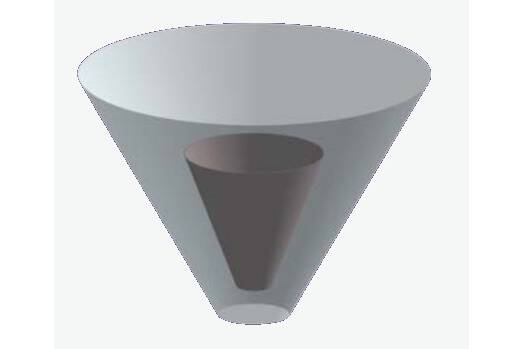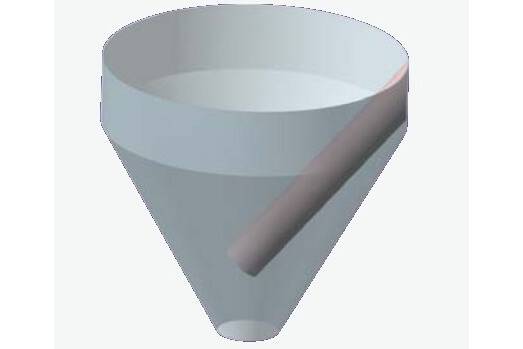The enormous volume of bulk materials handled every year means solids must be stored in hoppers, intermediate bulk containers, silos and other storage devices, often several times before being processed.
However, storage can result in a number of handling issues including erratic surges, arching, ratholes, packing, flushing, dead regions, feed upsets, and in some cases can reduce the suitability of the product for the next process stage

Hopper-in-hopper insert type

Lynflow Bates insert
Although it is seemingly counterintuitive to introduce an obstacle into the storage container as a solution to these problems, the use of inserts can enhance storage container performance.
An insert is usually a static fitting on the inside of a bulk storage container, including liners and other modifications that alter the internal space of a vessel. Flow regimes are determined by how the individual particles in a bulk solid respond to local forces at contact points. An insert alters the flow regime of a material by determining whether a particle moves, which direction it moves and if it remains intact.
Top Reasons for Using Inserts
- Counter segregation
- Reduce particle attrition
- Minimise dust generation
- Increase flow rates
- Expand the flow channel
- Alter the flow pattern
- Secure flow through smaller outlets
- Save headroom / Secure more capacity
- Prevent arching & ratholes
- Improve the extraction pattern
- Improve consistency e.g. density
Performance Objectives
One of the key questions to ask when investigating insert design is, what are the performance objectives? An optimal insert design will balance these objectives; some of which can be seen in ‘Top Reasons for Using Inserts’. Here we look at two of these reasons and how inserts can help enable them: Countering Segregation and Preventing Arching & Ratholes

Hopper-in-hopper insert type
Countering Segregation
Segregation can be countered in non-Mass Flow hoppers by either introducing an insert to diffuse the material upon entering the hopper, or using a tributary type insert to extract material from multiple regions during hopper emptying, or both. A Mass Flow pattern can re-mix products segregated during filling. When the level of material in the storage system falls to the point where the walls begin to converge, material flows faster in the centre than at the walls leading to regions with mainly coarse fractions. An insert can help by increasing the area of draw-down, or diluting local aggregations by drawing product from multiple locations.
Preventing Arching & Ratholes
If a bulk material has cohesive properties it may ’arch’ or ’bridge’ over an outlet. This depends upon many factors, such as the size and shape of the outlet, the time and degree of compaction, and whether the storage system is designed for Mass Flow or not.

Lynflow Bates insert
There are several insert options used for preventing arching including tube inserts to reduce bulk strength, a vibrating reed is sometimes used to break the arch and wall liners to decrease wall friction.
Even if a stable arch does not form, in a conical hopper a ’rathole’ may still form, leaving a large proportion of the hopper contents in dead regions. Ratholes can be prevented by using a ‘cone-in-cone’ insert to create a radial Mass Flow system within the cone insert whilst shielding the outer material to promote flow.
Insert Selection
It must be emphasised that inserts are not a cure-all for deficient designs. However, a well-designed insert can make a considerable difference to hopper discharge. Insert performance is dependent on hopper geometry, feeder type and operating conditions, therefore the design of inserts must be based on the overall system and the properties of the material used. The design of inserts when retrofitting will be influenced by space constraints, the structural integrity of the container, and the ability to install the insert in situ.
Research and Innovation
Many insert concepts and designs have been developed and introduced by equipment evolution, rather than arising from fundamental research. Ajax has been at the forefront of their exploitation in systems from mobile pharmaceutical bins to large steelworks bunkers. Recently Ajax has been collaborating with the University of Bolton in further researching the Lynflow™ Bates insert. For his final year project Vivek Ganesh, BEng (Hons) Mechanical Engineering, carried out trials with various poor flow and segregating bulk solids in conical hoppers fitted with the Bates insert. This is an inclined tube which projects over the outlet and produces a special skewed form of Mass Flow.
Vivek’s work revealed the change of flow pattern within geometries that wouldn’t normally allow Mass Flow without the insert fitted. There are, of course, still areas that need further fundamental research e.g. calculating stresses on inserts while filling and during flow conditions.



